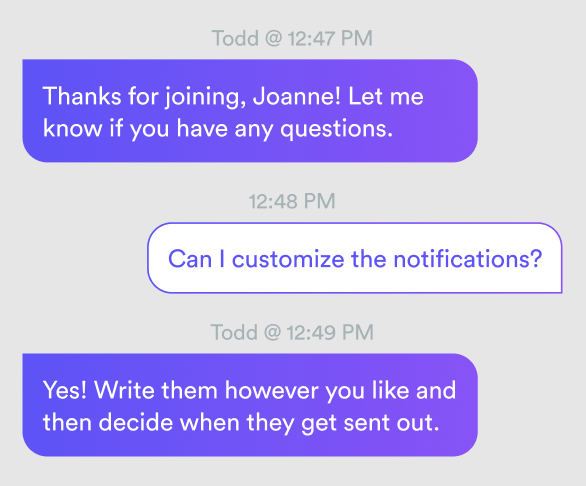How to Script an Effective On-Demand Product Demo — And Convert Leads Without Talking to Them!
87% of buyers want to self-serve part or all of their buying journey. And a whopping 57% are making purchase decisions without ever talking with a sales rep! (TrustRadius)
If you’re in sales, you’ve already realized it’s getting harder and harder to get a response from people.
That’s because the way consumers buy things has fundamentally changed — they want to research everything on their own rather than set up a call with a salesperson. They may only come to you when they're ready to make a final decision, if at all.
In other words, the sales process is now in the hands of the potential customer.
Think about the last time you wanted to buy something, what did you do? Did you do your own research, maybe ask a friend for their advice? Or did you run to a salesperson?
Once you accept this shift in buying behavior, you can adjust the way you sell to better align with prospects’ expectations. If you make the assumption your future customers are not going to talk to you before making a purchase, you can start thinking about how to approach your sales and marketing strategy differently.
One obvious solution is to make your product demos available on demand, but that begs the question, “If you can’t talk to prospects during a demo, how do you close the deal?”
In her sales workshop, The 5 Elements of an Effective On-Demand Demo: How To Convert Leads Without Talking to Them, eWebinar CEO Melissa Kwan shares a proven step-by-step presentation structure for delivering a high-quality on-demand product demo that will reliably convert leads on autopilot — around the clock 24/7. (Melissa’s own on-demand demo of eWebinar has a conversion rate of 25%!)
Watch Melissa’s free 30-minute sales workshop above, find it on YouTube, or keep reading for a summary of its key takeaways.
Workshop Resources
If you’ve seen Melissa’s workshop, here are the resources she mentions, including a product demo video script builder that you can use to craft the best product demo video possible!
-
On-demand demo video script builder ← MAKE A COPY TO GET STARTED!
-
Sales workshop on YouTube (36 min)
-
The Ultimate On-Demand Product Demo Template (Preview of eWebinar template)
-
Melissa's demo of eWebinar (A video example of an effective on-demand demo)
-
The Presentation Secrets of Steve Jobs (of Apple fame) by Carmine Gallo
The 5 Elements of an Effective On-Demand Demo
Here are the five elements of an effective on-demand sales demo. You should:
1. Set the agenda

Starting your demo with an agenda is a great way to set the expectations of what your audience is going to learn. It puts them in a different headspace and keeps them on track by giving them an idea of how you’re progressing so they’ll be less likely to interrupt you with questions.
When creating your agenda, lean on the “power of three” by breaking it down into three main items. This will make your demo sound simple and easy, which will also make your product sound simple and easy – and that’s exactly the result you want! No one wants a complicated new product with a steep learning curve.
Your agenda doesn’t need to be very specific, it just needs to cover the main ideas of what will be covered.
It does, however, need to pique the interest of your audience. There’s no one-size-fits-all recipe for on-demand demos because your business and target audience are unique. However, you might want to consider this good demo script template when setting up your agenda:
“Hello, thank you for joining me today. The purpose of this demo is to tell you a bit about our company and why we started it (the problem you solve), and to show you how our product works, how it’s different from what you may have already seen, and how easy it is to get set up so you can realize the benefit of our solution quickly.”
Keep it concise — your agenda should use up 30 seconds at the beginning of the demo script.
The agenda of a good demo script should address common objections, touch on pain points, and tease the solutions that you'll share upon delivering the main message. When in doubt, test and refine your sales demo script to find the most effective introduction that hooks your audience.
2. Tell your story (Introduction)
This is the section where you can dig deeper into who you are and what you and your company do.
Your introduction is a chance for viewers to “meet” you, and for you to build trust and credibility with them. If you’re the founder of your company, tell the story of why you started your business. How did you identify the problem you’re solving?
Share your background and why you’re the best person to solve this particular problem. People love a great story, and telling yours allows you to humanize your business and build a connection with your future customers.
If you’re not the founder, that’s okay too! You can accomplish the same thing by telling the origin story of your company from the founder’s perspective. Maybe you experienced the same thing and that’s why you decided to join the company. If so, share that story!
Positioning your introduction in this way establishes you as the subject matter expert. This might sound like common sense, but you’d be surprised how many demos are out there where the host doesn’t even do a simple introduction of themselves by stating their name!
If you like, you can ask a confirmation question to validate your point. A good example would be something like:
“Have you also experienced the problem I just described?”
With eWebinar, you can have pre-programmed questions pop up during your demo for your prospects to answer. The word “yes” is the most powerful word in sales, so getting your prospect to agree with you throughout the demo – even if it’s saying “yes” in their mind over and over again – will contribute to getting them to a “yes” at the end.
3. Address the competition

A key element of your introduction is to address your competition. You don’t need to mention competitors by name, just address the status quo you’re here to change. It’s the state of the world before you and why you exist today. This should fit nicely into your founder's story.
The reason for acknowledging the competition is that you have to assume that your prospects have already done their research. They know what’s out there, and they’re already wondering what makes you different from everyone else. You might as well control the conversation and use this as a way to differentiate yourself from the pack.
Even if your prospects haven’t done much research yet, assume they’re going to do so right after seeing your offering. If you educate them on what’s out there and how you compare to everyone else, it will help them choose you as their preferred product and lower the risk of them going somewhere else.
Addressing your competition is also a way to handle objections before they even come up, and that puts your prospects’ minds at ease and builds credibility for you. Doing additional research to get to know your audience (and the specific pain points they deal with) will boost your success rates here.
Talking about your competitors shows that you're confident about your product and that you’re knowledgeable about the status quo. Your viewers might even be users of another product who are experiencing the pain points you’ve already solved, so getting them to agree with you on what’s lacking in their current situation helps get them on your side.
Remember – the competition is why your product needs to exist. Communicating that to your audience should be a top priority.
NOTE: The three steps mentioned above should take no longer than 5-7 minutes. You’ll want to dive into your demo fairly quickly because your prospect will be eager to see what you have. And the quicker you start your demo, the more time you'll have to show how your product can make the viewers’ lives better!
4. Reveal the solution (Demo)
Once you’ve established why your solution exists, you can reveal it as the hero of your story, as the thing that will solve your viewers’ biggest pain points. This is the heart of your presentation and sales pitch, where you can solidify your product as the clear winner.
It’s easy to fall into the trap of simply giving a tutorial or walkthrough of all of your product’s features. Don’t do that! Only talk about the ones that make your product unique and stand out from the competition. Especially don’t talk about the things a product like yours is expected to have.
The most important thing is that you take the time to showcase your 10X feature. According to Jason Lemkin, the founder of SaaStr, your 10X feature is a specific feature that "for a material number of customers and prospects, wins the deal vs. the competition. Period. Not always, but often.”
We recommend you practice your demo script a couple of times before recording this section. The delivery doesn't have to be pristine (and you know your audience best) but you should make sure to get the main message across, highlight key features and benefits, and list common goals and expectations.
Chat: eWebinar’s 10X feature
eWebinar is the only platform that gives you the ability in an on-demand demo to chat live with prospects when you can, and the flexibility to respond later via email when you can’t. If you want to retain the interactivity of chat in your demo, be sure to check out eWebinar.

This helps you save time while still being able to follow up with prospects who have already been primed by your winning software demo script. You can learn about how our chat works — from our automated welcome messages to our Slack integration — in our 20-minute on-demand product demo.
Suffice it to say that you'll have multiple options for responding to relevant questions from attendees.
The truth is your product's functionality isn’t the most important thing for your prospects to learn. What they really need to understand is how your product will impact their lives in a meaningful way, and what outcomes they'll be able to achieve from your product’s differentiating features.
Your job, through your demo, is to help them make that connection.
Social validation helps build credibility in this area, so use testimonials from customers when possible. You might also want to mention names of recognizable companies that use your product in a specific (and similar) way.
Connect functionality to use cases to help your prospect envision what their day could look like with your solution in it. Also feel free to share articles, case studies, examples of effective software, and any other resources that your viewers can read up on after your demo is over.
eWebinar makes it easy to do this through our post-webinar email sequences. These automated emails are the perfect opportunity to reinforce the main message of your webinar, request a follow-up call with interested prospects, and remind attendees of the pain points that you can alleviate for them.
5. Ask for the close (CTA)

After your product demonstration, and before you announce your call to action (CTA), be sure to open it up for questions. This makes for an easy transition and signifies that your demo has come to an end.
Even in an automated software demo, and even if you’ve asked your viewers to send in questions throughout the entire presentation, this is an important step because it encourages them to send any remaining feedback to you (and this feedback can be used to improve and enrich future on-demand demos).

Once this is done, you can end your presentation by delivering your CTA. There’s no magic bullet when it comes to this; the most important thing is to just make sure you do it!
Some potential CTAs, depending on what your product and sales process are, could be:
-
Sign up for a free trial
-
Purchase your product (perhaps with a money-back guarantee if you want to give the customer peace of mind)
-
Book a time on your calendar for an in-depth call (like for an enterprise product)
-
Request to be contacted
Choose the CTA that’s right for your business, and make sure viewers know how to get in touch with you for additional questions. To further help your potential customers self-educate, consider sharing an FAQ document at the end.
If you want to learn more, check out our full guide on writing an effective call-to-action for automated webinars.
Bonus: Refine your demo script
You should test and refine your demo script to ensure over time. eWebinar tracks plenty of useful metrics that help you refine your demo script such as dollar per attendee, conversion rates, and engagement heatmaps throughout the sales or product demo.
These insights will help you craft a demo script that converts to the best of its ability.
Closing thoughts
And that’s it! If you keep these best practices in mind while creating software demo scripts then attendees will surely take the next step towards becoming a customer. This article serves as your guide to writing a great product demo that will convert leads into customers on autopilot.
Want to see a real-life video example of this demo structure in action? Head over to ewebinar.com and join the on-demand demo on our website. You should be able to recognize the five elements in it pretty easily!
Need help with writing a winning demo script? We’ve made a really handy demo script template that you can copy and use to get started on crafting your own effective on-demand sales demonstration video today!
Need help with video production? Check out our recommendations for software and hardware that you can use when making great video content. The type of video you create — from something straightforward like a screen recording with voiceover to something more complex like an animated video with background music — will determine the video editing software you use. Just remember, fancy visuals are far less important than the right structure and substance. Keep it simple!
Ready to automate your pre-recorded webinar? When it's time to put your own demo on autopilot, we encourage you to take a look at what eWebinar has to offer, including:
-
Our robust chat system which lets your prospects connect with you directly (it’s our 10X feature – nobody else does anything like it).
-
Our variety of interactions — from polls and questions to contact forms and conversion alerts — which create an interactive experience that will hold your viewer’s attention from beginning to end.
-
Our flexible scheduling options let attendees join your demo when it works best for them, whether that’s right away or at a convenient time of day in their time zone.
-
Our follow-up call-to-action sequences are sent through email and prompt attendees to take the next step after attending your sales or product demo.
-
A free automated webinar template for on-demand product demos that follows Melissa's presentation structure, including email cadences, suggested landing page copy, and 20+ preset interactions you can use to keep attendees engaged.
Watch a two-minute explainer video for a quick overview of the eWebinar platform. Or, better yet, join our on-demand demo to learn more!









